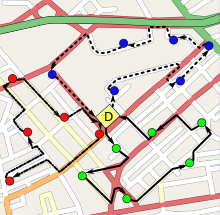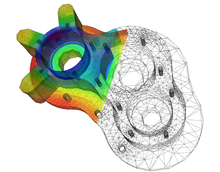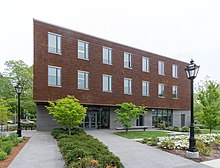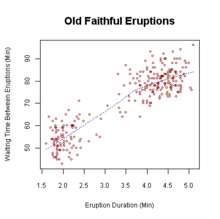Mathematics is an area of knowledge that includes the topics of numbers, formulas and related structures, shapes and the spaces in which they are contained, and quantities and their changes. These topics are represented in modern mathematics with the major subdisciplines of number theory, algebra, geometry, and analysis, respectively. There is no general consensus among mathematicians about a common definition for their academic discipline.
Computer science is the study of the theoretical foundations of information and computation and their implementation and application in computer systems. One well known subject classification system for computer science is the ACM Computing Classification System devised by the Association for Computing Machinery.

An academic discipline or field of study is a branch of knowledge, taught and researched as part of higher education. A scholar's discipline is commonly defined by the university faculties and learned societies to which they belong and the academic journals in which they publish research.
Theoretical computer science (TCS) is a subset of general computer science and mathematics that focuses on mathematical aspects of computer science such as the theory of computation (TOC), formal language theory, the lambda calculus and type theory.
A computer scientist is a scholar who specializes in the academic study of computer science.
Lists of mathematics topics cover a variety of topics related to mathematics. Some of these lists link to hundreds of articles; some link only to a few. The template to the right includes links to alphabetical lists of all mathematical articles. This article brings together the same content organized in a manner better suited for browsing. Lists cover aspects of basic and advanced mathematics, methodology, mathematical statements, integrals, general concepts, mathematical objects, and reference tables. They also cover equations named after people, societies, mathematicians, journals, and meta-lists.
Feng Kang was a Chinese mathematician. He was elected an academician of the Chinese Academy of Sciences in 1980. After his death, the Chinese Academy of Sciences established the Feng Kang Prize in 1994 to reward young Chinese researchers who made outstanding contributions to computational mathematics.
Computational science, also known as scientific computing, technical computing or scientific computation (SC), is a division of science that uses advanced computing capabilities to understand and solve complex physical problems. This includes

The Courant Institute of Mathematical Sciences is the mathematics research school of New York University (NYU). Founded in 1935, it is named after Richard Courant, one of the founders of the Courant Institute and also a mathematics professor at New York University from 1936 to 1972, and serves as a center for research and advanced training in computer science and mathematics. It is located on Gould Plaza next to the Stern School of Business and the economics department of the College of Arts and Science.
Society for Industrial and Applied Mathematics (SIAM) is a professional society dedicated to applied mathematics, computational science, and data science through research, publications, and community. SIAM is the world's largest scientific society devoted to applied mathematics, and roughly two-thirds of its membership resides within the United States. Founded in 1951, the organization began holding annual national meetings in 1954, and now hosts conferences, publishes books and scholarly journals, and engages in advocacy in issues of interest to its membership. Members include engineers, scientists, and mathematicians, both those employed in academia and those working in industry. The society supports educational institutions promoting applied mathematics.

Stanley Osher is an American mathematician, known for his many contributions in shock capturing, level-set methods, and PDE-based methods in computer vision and image processing. Osher is a professor at the University of California, Los Angeles (UCLA), Director of Special Projects in the Institute for Pure and Applied Mathematics (IPAM) and member of the California NanoSystems Institute (CNSI) at UCLA.
Computational mechanics is the discipline concerned with the use of computational methods to study phenomena governed by the principles of mechanics. Before the emergence of computational science as a "third way" besides theoretical and experimental sciences, computational mechanics was widely considered to be a sub-discipline of applied mechanics. It is now considered to be a sub-discipline within computational science.
Engineering mathematics is a branch of applied mathematics concerning mathematical methods and techniques that are typically used in engineering and industry. Along with fields like engineering physics and engineering geology, both of which may belong in the wider category engineering science, engineering mathematics is an interdisciplinary subject motivated by engineers' needs both for practical, theoretical and other considerations outside their specialization, and to deal with constraints to be effective in their work.

Computational Engineering is an emerging discipline that deals with the development and application of computational models for engineering, known as Computational Engineering Models or CEM. Computational engineering uses computers to solve engineering design problems important to a variety of industries. At this time, various different approaches are summarized under the term Computational Engineering, including using computational geometry and virtual design for engineering tasks, often coupled with a simulation-driven approach In Computational Engineering, algorithms solve mathematical and logical models that describe engineering challenges, sometimes coupled with some aspect of AI, specifically Reinforcement Learning.

The Department of Mathematics at the University of Manchester is one of the largest unified mathematics departments in the United Kingdom, with over 90 academic staff and an undergraduate intake of roughly 400 students per year and approximately 200 postgraduate students in total. The School of Mathematics was formed in 2004 by the merger of the mathematics departments of University of Manchester Institute of Science and Technology (UMIST) and the Victoria University of Manchester (VUM). In July 2007 the department moved into a purpose-designed building─the first three floors of the Alan Turing Building─on Upper Brook Street. In a Faculty restructure in 2019 the School of Mathematics reverted to the Department of Mathematics. It is one of five Departments that make up the School of Natural Sciences, which together with the School of Engineering now constitutes the Faculty of Science and Engineering at Manchester.
Mathematics is a broad subject that is commonly divided in many areas that may be defined by their objects of study, by the used methods, or by both. For example, analytic number theory is a subarea of number theory devoted to the use of methods of analysis for the study of natural numbers.










